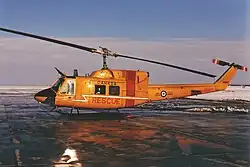
Ferry flying is the flying of aircraft for the purpose of returning to base, delivery to a customer, moving from one base of operations to another or moving to or from a maintenance facility for maintenance, repair, and operations.[1]
A commercial airliner may need to be moved from one airport to another to satisfy the next day's timetable or facilitate routine maintenance. This is commonly known as a positioning flight or repositioning flight, and may carry revenue freight or passengers as local aviation regulations and airline policies allow.[2] Such flights may be necessary following a major weather event or other similar disruption which causes multiple cancellations across an airline's network resulting in many aircraft and crew being out of position for normal operations; the 2010 eruptions of Eyjafjallajökull or the mass evacuation of US airspace following the 9/11 attacks being significant examples of this.
Ferry permit
A ferry permit is a written authorization issued by a National Airworthiness Authority to move a non-airworthy civil aircraft from its present location to a maintenance facility to be inspected, repaired and returned to an airworthy state.[1]
Ferry pilots
Louise Sacchi flew single- and multi-engine planes 340 times across both the Atlantic and Pacific oceans, breaking several records in the process.[3]
Other notable ferry pilots include:
- Helen Marcelle Harrison Bristol
- Lettice Curtis
- Maureen Dunlop de Popp
- Mary Ellis, WWII pilot in the United Kingdom
- Luis Fontés
- Joan Hughes
- Amy Johnson
- Jim Mollison (Amy Johnson's husband)
- Robert Neale
- Robert Olds
- Jarvis Offutt
- Jadwiga Piłsudska
- C. W. A. Scott
- Diana Barnato Walker
See also
- Air Transport Auxiliary
- Dead mileage, a similar concept in ground transportation
- Ferry range
- RAF Ferry Command
- United Kingdom aircraft test serials
- Women Airforce Service Pilots
References
- 1 2 Crane, Dale (1997). "Ferry flying". Dictionary of Aeronautical Terms (third ed.). Aviation Supplies & Academics. p. 210. ISBN 1-56027-287-2.
- ↑ Claiborne, Matt. "What Are Ferry Flights and Positioning Flights". aerocorner.com. Retrieved May 13, 2021.
- ↑ "Highlights of Louise Sacchi's Aviation History". The Ninety Nines. Archived from the original on 2008-05-14.
Further reading
- Thurber, Matt (April 5, 2018). "A Long Trip in a TBM 910". AIN.